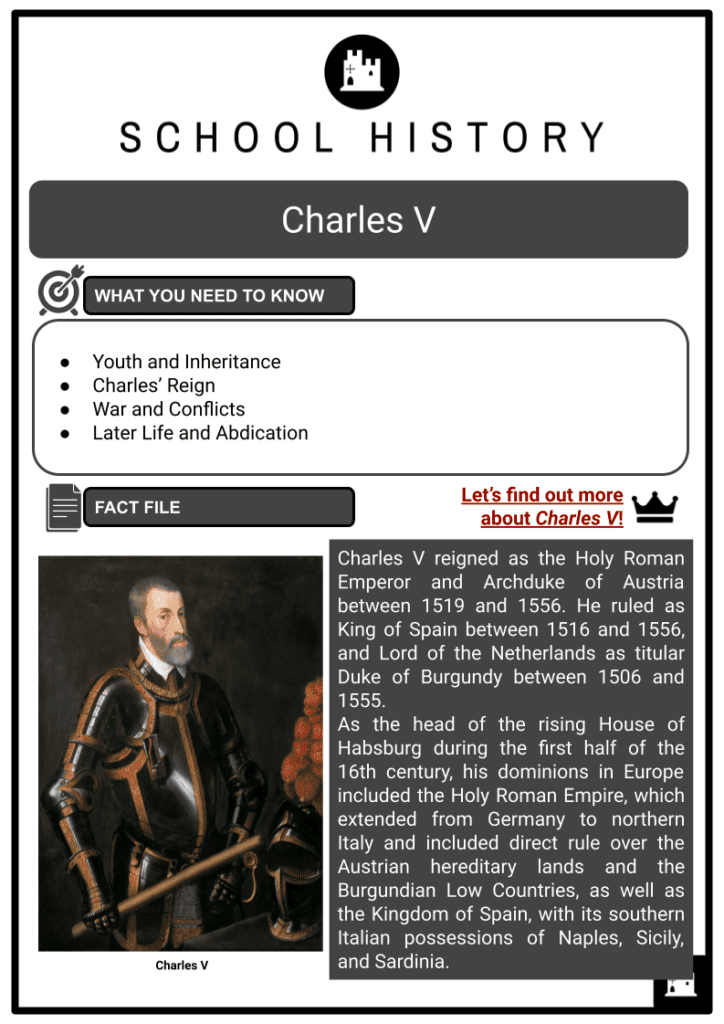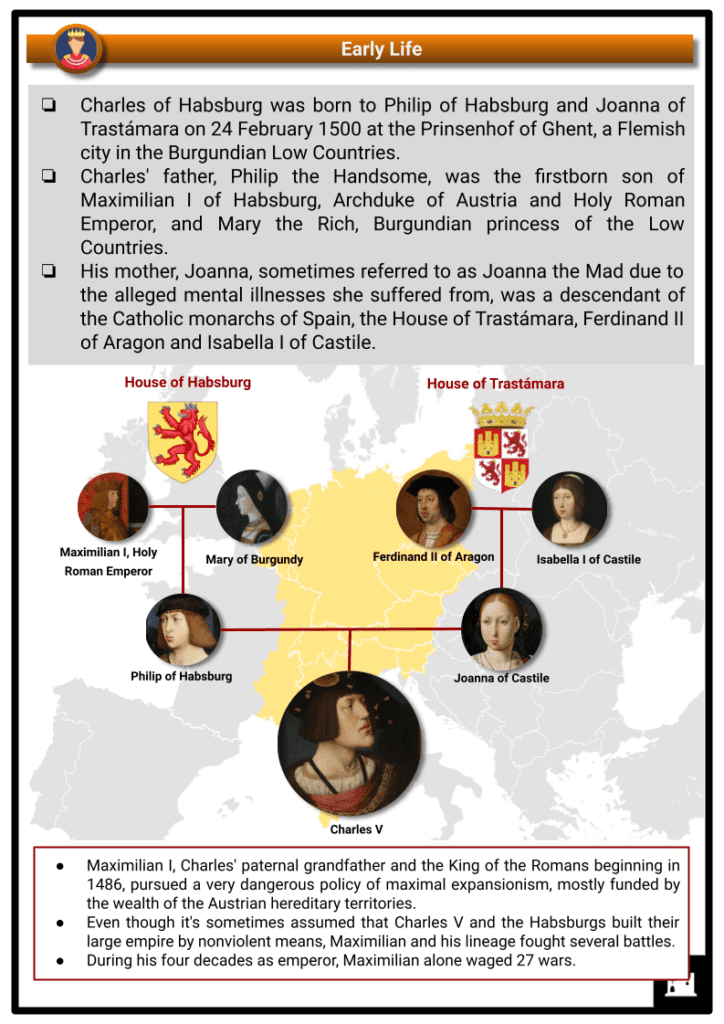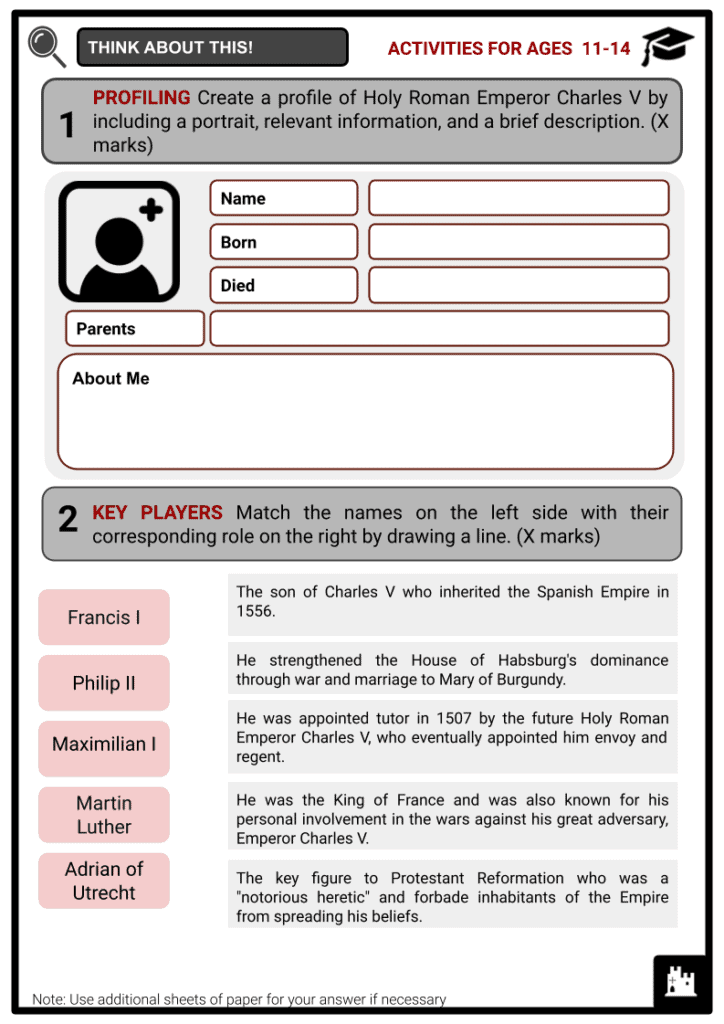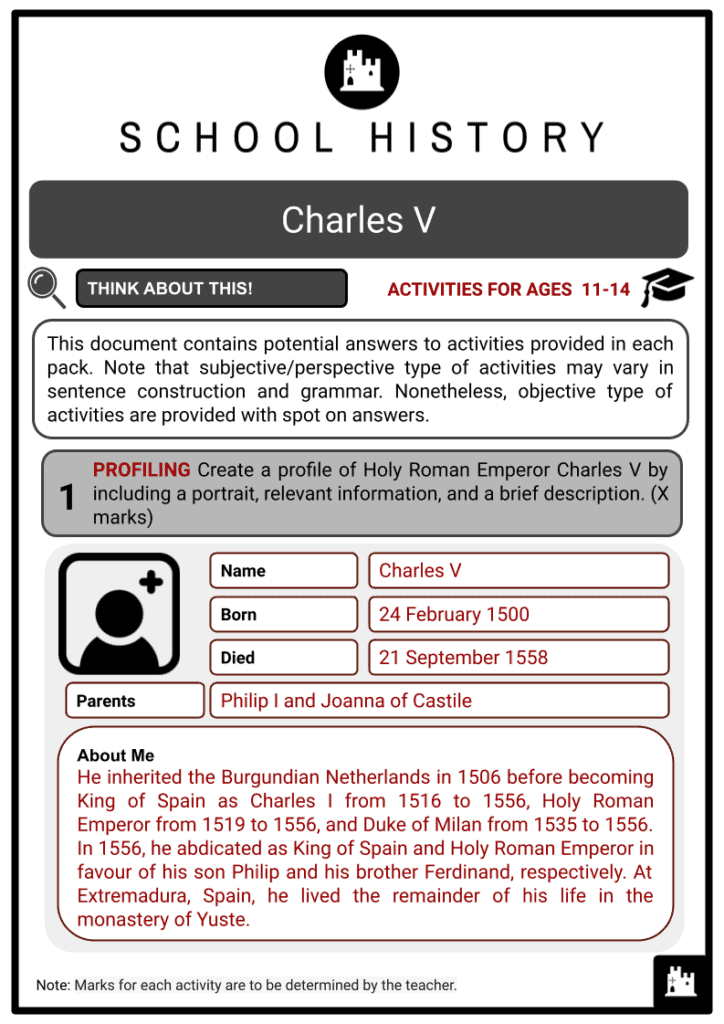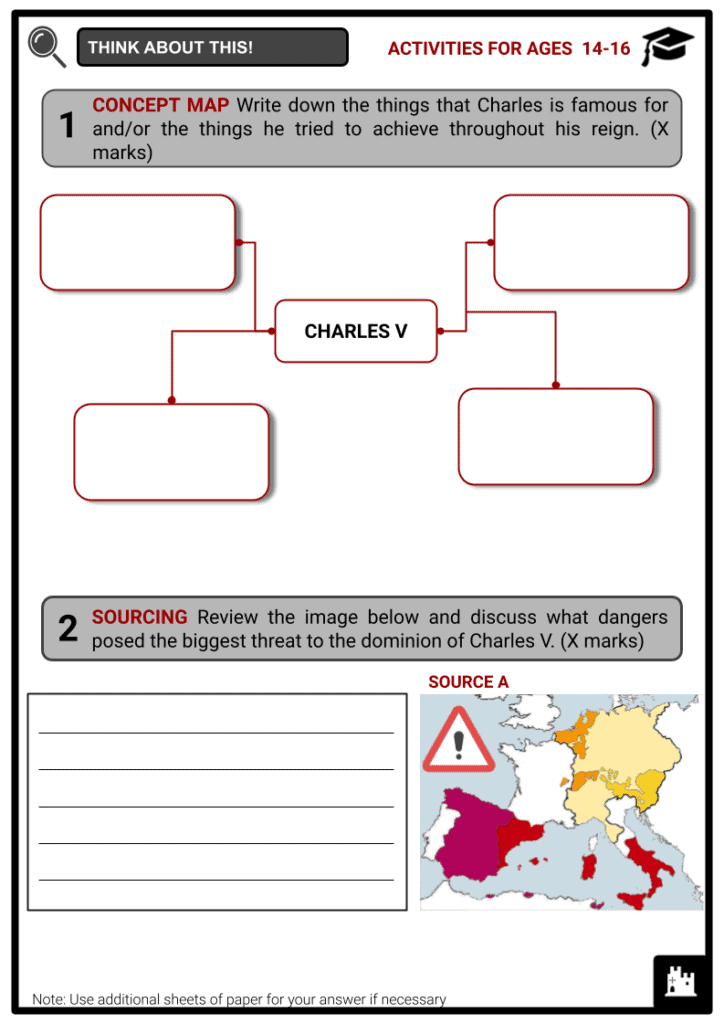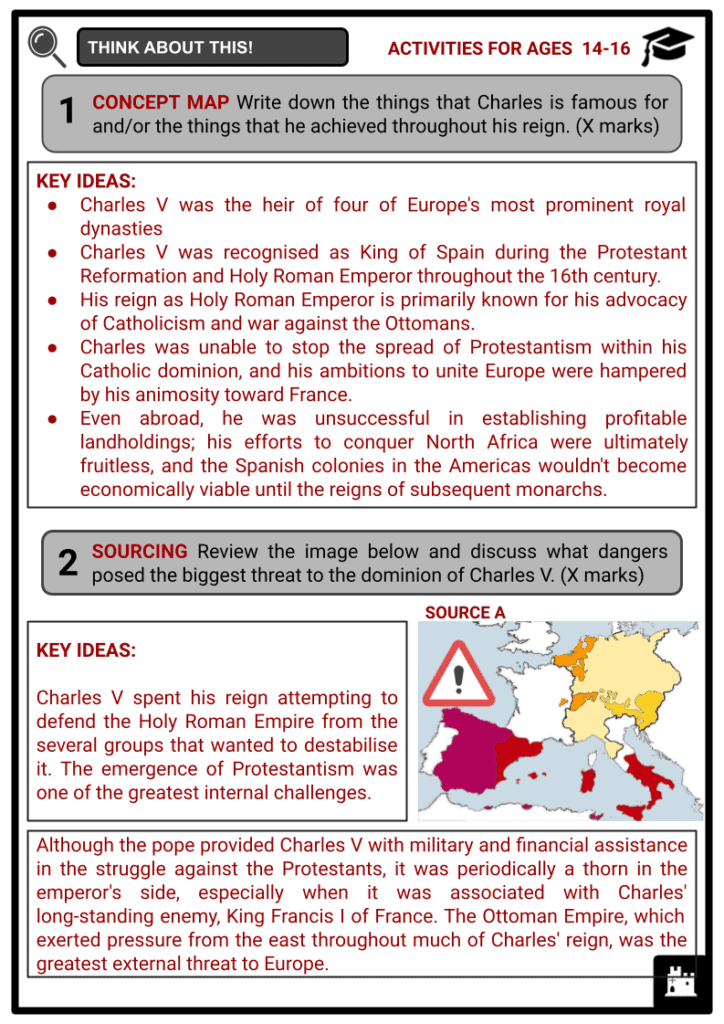Charles V Worksheets
Do you want to save dozens of hours in time? Get your evenings and weekends back? Be able to teach about Charles V to your students?
Our worksheet bundle includes a fact file and printable worksheets and student activities. Perfect for both the classroom and homeschooling!
Summary
- Youth and Inheritance
- Charles’ Reign
- War and Conflicts
- Later Life and Abdication
Key Facts And Information
Let’s find out more about Charles V!
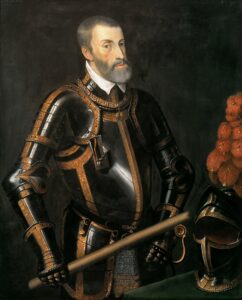
Charles V reigned as the Holy Roman Emperor and Archduke of Austria between 1519 and 1556. He ruled as King of Spain between 1516 and 1556, and Lord of the Netherlands as titular Duke of Burgundy between 1506 and 1555. As the head of the rising House of Habsburg during the first half of the 16th century, his dominions in Europe included the Holy Roman Empire, which extended from Germany to northern Italy and included direct rule over the Austrian hereditary lands and the Burgundian Low Countries, as well as the Kingdom of Spain, with its southern Italian possessions of Naples, Sicily, and Sardinia.
Early Life
- Charles of Habsburg was born to Philip of Habsburg and Joanna of Trastámara on 24 February 1500 at the Prinsenhof of Ghent, a Flemish city in the Burgundian Low Countries.
- Charles' father, Philip the Handsome, was the firstborn son of Maximilian I of Habsburg, Archduke of Austria and Holy Roman Emperor, and Mary the Rich, Burgundian princess of the Low Countries.
- His mother, Joanna, sometimes referred to as Joanna the Mad due to the alleged mental illnesses she suffered from, was a descendant of the Catholic monarchs of Spain, the House of Trastámara, Ferdinand II of Aragon and Isabella I of Castile.
- Maximilian I, Charles' paternal grandfather and the King of the Romans beginning in 1486, pursued a very dangerous policy of maximal expansionism, mostly funded by the wealth of the Austrian hereditary territories.
- Even though it's sometimes assumed that Charles V and the Habsburgs built their large empire by nonviolent means, Maximilian and his lineage fought several battles.
- During his four decades as emperor, Maximilian alone waged 27 wars.
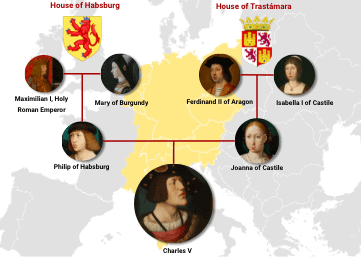
- The political union of Philip and Joanna was initially proposed in a letter written by Maximilian to Ferdinand in order to secure an Austro-Spanish alliance against the Kingdom of France during the Italian Wars, which was founded as part of the League of Venice.
- Unexpectedly, the marriages between the Habsburgs and the Trastámaras, which were initially meant as a marital alliance against France, brought the crowns of Castile and Aragon to Maximilian's male line.
- Philip and Joanna's marriage contract was signed in 1495, and celebrations were conducted on 20 October 1496. Philip was already the Duke of Burgundy and the heir apparent to the throne of Austria as the Archduke. In comparison, Joanna was only third in the Spanish succession line.
- Joanna gave birth to Charles at 3 a.m. in the bathroom of the Prinsenhof shortly after attending a ball despite experiencing labour pains. His name was selected by Philip in honour of Charles I of Burgundy.
- Given the dynastic circumstances, Charles was initially merely the heir apparent of the Burgundian Low Countries as the honorary Duke of Luxembourg, and in his early years, he was known as Charles of Ghent.
- His godfathers were Charles I de Cro and John III of Glymes, while his godmothers were Margaret of York and Margaret of Austria. His baptism took place at the Church of Saint John and was presided over by the Bishop of Tournai. In keeping with Burgundian chivalric tradition, Charles was presented with a sword and a helmet during his baptism. These items symbolised, respectively, the weapon of war and the emblem of peace.
- In 1501, Philip and Joanna left Charles in Margaret of York's care and traveled to Spain to get Joanna recognised as Princess of Asturias. When Isabella died in 1504, Joanna became Queen of Castile.
- In 1506, Philip was officially crowned king, but shortly after, he passed away. The trauma of that incident drove the already unstable Joanna completely insane, and she retired in isolation.
Charles’ Reign
Burgundy and the Low Countries
- Charles inherited the Low Countries and was elevated to the position of Duke of Burgundy, but since he was a minor, his aunt Margaret acted as regent until 1515. He was also given the titles of Prince of Asturias (heir apparent to the Spanish throne) and honorary archduke (heir apparent of Austria).
- The Habsburg Netherlands, which encompassed several of the lordships that made up the Low Countries and included modern-day Belgium, the Netherlands, and Luxembourg, were part of the Burgundian inheritance.
- After Philip's death in 1506, Charles was crowned Charles II of Burgundy and acknowledged as Lord of the Netherlands. Charles spent his youth at Mechelen with his sisters Mary, Eleanor, and Isabella, as well as his aunt Margaret of Austria, Duchess of Savoy.
- In his youth, Charles did not have any especially stunning appearance. He was considered fragile, had a pale complexion, acquired a prominent lower jaw, and was rumoured to be timid. He was more interested in horses, hunting, tournaments, and fencing than in academic endeavours.
- The culture of the Low Countries had a significant impact on Charles' development of values and beliefs. As an infant and subsequently grandmaster of the Burgundian Order of the Golden Fleece, Charles was trained in the principles of the medieval knights and the yearning for Christian unity to oppose the infidel.
- Both William de Cro (who would go on to become prime minister) and Adrian of Utrecht (who would become Pope Adrian VI) served as his tutors.
- Guillaume de Croy, Lord of Chievres was another influential figure in Charles' political growth. In 1506, he had become the most powerful lord in the Low Countries, and in 1509, Charles named him governor and Grand Chamberlain.
- Chievres spent a lot of time with Charles and, like Margaret, made sure Charles was exposed to the leadership skills and responsibilities. While Margaret considered Charles as the future leader of the Habsburg family, Chievres saw him as the Duke of Burgundy and vowed to utilise all means to serve Burgundian interests.
Spain
- Spain and the Castilian colonies in the Americas and the Aragonese kingdoms of Naples, Sicily, and Sardinia were all part of the Spanish heritage after a dynastic union of the crowns of Castile and Aragon.
- On May 30, 1516, upon the death of his great-grandfather Ferdinand II, Charles became the first king of an unified Spain. Charles inherited his grandfather's kingdom, which encompassed Aragon, Navarre, Naples, Sicily, and Sardinia.
- He also became co-king of Castile and guardian of his mother, Joanna. The kingdoms of Castile and Aragon were unified for the first time by one person. With the kingdom of Castile, he also acquired Granada and the Spanish colonies in the New World.
- Castile and Aragon constituted the largest of Charles' personal domains, and they also supplied a huge number of generals and tercios (the fearsome Spanish infantry of the period), whilst Joanna was confined in Tordesillas until her death.
- Charles was considered as a foreign prince upon his succession to the throne.
- In the fall of 1517, Charles landed in his new kingdoms.
- Difficult negotiations ensued with the Castilian Cortes, but in the end, Charles was accepted on the following terms: he would learn to speak Castilian (Spanish); he would not appoint foreigners; he would not remove valuable metals from Castile; and he would preserve the rights of his mother, Queen Joanna.
- Because of the harsh taxation - funds that were used to conduct wars overseas, conflicts that most Castilians had little interest in - and because Charles preferred to appoint Flemings for high offices in Spain and America while disregarding Castilian candidates, opposition to the Emperor grew quickly. The resistance resulted in the Revolt of the Comuneros, which Charles put down.
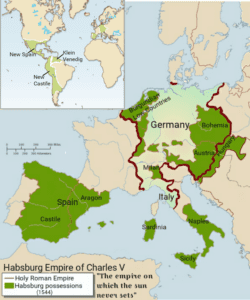
The pinnacle of Charles V's empire
America
- During the reign of Charles, conquistadors such as Hernán Cortés and Francisco Pizarro significantly expanded New Spain's territory, bringing the Aztec and Inca empires to their knees in less than a decade.
- Along with his voyage of the globe in 1522, this gave Charles a strong sense of his divine purpose to become the leader of the Christian world.
- The conquests also brought copious quantities of bullion to the national treasury.
- Charles called for a meeting in Valladolid in 1550 to discuss the ethics of using force against the native peoples of Spain's New World colonies.
- On 28 August 1518, Charles approved a charter enabling the direct shipment of enslaved Africans to the Americas.
- The decision to establish a direct, more economically feasible slave trade between Africa and the Americas substantially altered the nature and extent of the transatlantic slave trade.
War and Conflicts
- In 1519, with the death of Charles' grandfather, Maximilian, he acquired Austrian Habsburg territories. Clearly, Charles was also a candidate to succeed Maximilian as Emperor, but he had to compete with King Francis I of France, who had the support of Pope Leo X.
- Francis utilised promises and bribery to win over the voters, but with the assistance of the rich Fugger family, Charles was able to overthrow Francis and was elected as the Holy Roman Emperor on 28 June 1519.
- In 1530, Pope Clement VII crowned him Holy Roman Emperor in Bologna, making him the last Emperor to undergo a papal coronation.
War with France
- France was geographically surrounded by the Habsburg monarchy as a result of Charles V's accession to the thrones of Spain, the Burgundian Netherlands, and the Holy Roman Empire.
- Charles' reign was mostly consumed by conflicts with France. Charles' first conflict with his archenemy, Francis I of France, started in 1521.
- With the help of England and Pope Leo X, Charles led an effective campaign against France and Venice, which resulted in the expulsion of the French from Milan, the defeat and capture of Francis at the Battle of Pavia in 1525, and the humiliating Treaty of Madrid the following year, in which Francis was forced to cede Burgundy to Charles. The win guaranteed Spanish dominance in Italy. Francis pretended to accept the terms imposed by Charles. The Treaty of Madrid, which ended hostilities between the two nations, was signed in January 1526, but Francis refused to accept it as soon as he was freed.
- As a result, France joined Pope Clement VII's League of Cognac alongside other European powers including England's Henry VIII, Venice, Florence, and Milan to resist Italy's imperial rule.
- As a result of the war that ensued, Henry VIII of England and Charles' aunt Catherine of Aragon were unable to have their marriage annulled by Pope Clement VII because of Charles' Sack of Rome and Clement's virtual imprisonment in 1527. This led to Henry's eventual break with Rome and the beginning of the English Reformation.
- In 1535, when the last Sforza Duke of Milan died, Charles appointed his own son Philip as duke against Francis' will, sparking a third conflict between the two rivals.
- Though Francis was ultimately unsuccessful in his attempt to take Milan, he was able to take the domains of Charles' ally the Duke of Savoy and turn Turin as his capital. The conflict was temporarily put to rest by a treaty signed at Nice in 1538.
- In 1542, Francis openly collaborated with Ottoman Sultan Suleiman I, and Charles joined with Henry VIII, resuming the Italian war.
- An Anglo-Imperial invasion of northern France, led by Charles himself, won some successes but was ultimately abandoned, leading to another peace and the restoration of the status quo ante bellum in 1544.
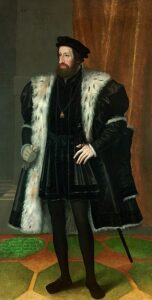
Ferdinand I - Despite the conquest of Nice by a Franco-Ottoman fleet, the French remained unable to advance into Milan.
- In 1551, a last struggle broke out with Francis' son and successor, Henry II. Even though Henry had an early victory in Lorraine and conquered Metz, French offensives in Italy were unsuccessful. As the war progressed, Charles abdicated, leaving his son, Philip II, and his brother, Ferdinand I, Holy Roman Emperor, in charge.
War against the Ottoman Empire
- For several years, Charles fought against the Ottoman Empire and its sultan, Suleiman the Magnificent. The Ottoman attacks throughout the Mediterranean constituted a danger to Habsburg territory and the peace of Western Europe.
- In 1529, the Turkish advance in Central Europe was halted at Vienna, which they unsuccessfully besieged. Charles gained a significant victory at Tunis in 1535, but Francis I of France sided with Suleiman against him in 1536.
- Francis was convinced to sign a peace pact in 1538, but in 1542 he re-aligned himself with the Ottomans, known as Franco-Ottoman alliance.
- Francis was obliged to sign the Truce of Crepy-en-Laonnois in 1543, after Charles aligned himself with Henry VIII and forced him to do so.
- Although the war was not over, Charles subsequently signed a humiliating contract with the Ottomans to get some relief from the enormous costs of the conflict.
Protestant Reformation
- It was under the reign of Charles V that the Protestant Reformation first came to the attention of the imperial government.
- Charles V used religious harmony as a unifying force to rule his many domains, and he saw Luther's ideas as a dangerous type of heresy.
- During his reign as Holy Roman Emperor, Charles invited Martin Luther to the Diet of Worms in 1521 and assured him of protection if he showed up.
- Martin Luther was a professor, author, hymn writer, and priest from Germany. He is mostly recognised as the pivotal figure in the Protestant Reformation. The Protestant Reformation was a major movement within Western Christianity in 16th-century Europe that provided a theological and political challenge to the Catholic Church and, in particular, papal power as a result of the Catholic Church's alleged faults, abuses, and inconsistencies. The Reformation marked the beginning of Protestantism and the division of the Western Church into Protestantism and the Roman Catholic Church.
- Emperor Charles called Martin Luther to the Diet to renounce or confirm his beliefs in response to the decree issued by Pope Leo X. In response to interrogation, he upheld his opinions and refused to abandon them.
- At the conclusion of the Diet, the Emperor issued the Edict of Worms, a document that labelled Luther a "notorious heretic" and forbade inhabitants of the Empire from spreading his beliefs.
- Philip Melanchthon, Luther's assistant, presented Charles V with the Augsburg Confession that is considered to be the foundational document of Lutheranism.
- The emperor vehemently opposed it, and in 1531, Protestant lords created the Schmalkaldic League, an alliance of Lutheran princes for military purposes within the Holy Roman Empire.
- In 1532, Charles V acknowledged the League, thus suspending the Edict of Worms with the Nuremberg halt. The stagnation compelled Protestants to continue participating in the Imperial wars against the Turks and the French and postponed religious concerns until the Pope convened a general council of the Catholic Church to resolve the problem.
- In 1545, the start of the Council of Trent marked the beginning of the Counter-Reformation, and Charles won over other princes of the Holy Roman Empire to the Catholic cause.
- Charles also fought the Schmalkaldic League in 1546 and defeated John Frederick, Elector of Saxony and Philip of Hesse at the Battle of Mühlberg in 1547. In 1548, he proposed a theological compromise that he believed both Catholics and Protestants might support at the Augsburg Interim. The Peace of Augsburg in 1555 brought in a more permanent settlement.
- It formally ended the religious conflict between the two factions and cemented the legal separation of Christianity within the Holy Roman Empire, allowing leaders to choose either Lutheranism or Roman Catholicism as the state religion.
Later Life and Abdication
- Charles married his first cousin, Isabella of Portugal, sister of John III of Portugal, on 10 March 1526. Charles and Isabella had seven children, but only three survived infancy.
- Philip II of Spain ( 1527 - 1598)
- Maria of Spain ( 1528 - 1603)
- Joan of Habsburg ( 1537 - 1573)
- Charles suffered from an enlarged lower jaw (mandibular prognathism), a congenital condition that worsened significantly in following Habsburg generations, thus the term Habsburg jaw.
- This deformity may have been caused by the family's lengthy history of inbreeding, which resulted from frequent marriages between close relatives to retain dynastic control over territory.
- He suffered from epilepsy and was severely ill with gout, which was likely brought on by a diet rich in red meat. His gout developed from painful to incapacitating as he matured.
- During his retirement, he was pushed around the St. Yuste monastery in a sedan chair. A ramp was installed to facilitate his access to his chambers.
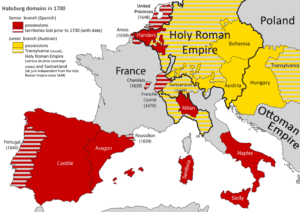
Map showing the Habsburg dominions following Charles V's partition - In 1556, Charles renounced his multiple titles, transferring his personal empire to his son Philip II of Spain and the Holy Empire to his brother Ferdinand I. Charles withdrew to the monastery of Yuste in Extremadura, but continued to correspond frequently and maintain an interest in the empire's condition.
- After Charles abdicated as Emperor, Ferdinand began ruling Austria and his other territories. Despite Philip and his descendants' claims, Hungary and Bohemia were still under the nominal and substantial dominion of Ferdinand and his successors.
- Some researchers believe Charles V opted to abdicate after a gout attack in 1552 prevented him from attempting to reclaim the French city of Metz, where he was ultimately defeated.
- On 21 September 1558, Charles passed away at the age of 58. His remains were moved to the Royal Pantheon of The Monastery of San Lorenzo de El Escorial 26 years later.

